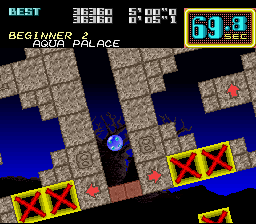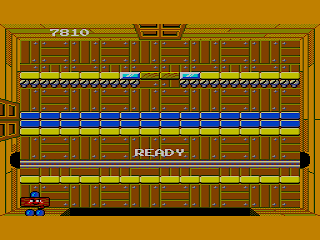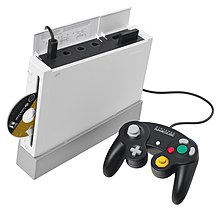Home gaming has been around about as long as I have, and the
industry has made astonishing progress in the forty years since the first Pong
machines were parked in front of the family television set. Unfortunately, in
our race to advance the hobby, we tend to leave its earlier innovations in the
dust.
 |
| It's alive! ALIVE! |
Take the dial controller, for instance. What used to be standard
equipment for game consoles has become a little-seen novelty, compatible with
just a few games and often carrying a hefty price tag. (Seriously, look up a JogCon or a Vaus controller on eBay sometime. You'll plotz.)
There are no mass-produced dials at all for home computers,
which is especially frustrating when you consider the many emulators that
support them. Sure, you could use a mouse or an analog joystick instead, but
the only way to get the precision and the feel of a dial is to build one
yourself. Fortunately, it’s possible to build one from spare parts… a laser mouse
here, a few buttons there, the knob from an Atari paddle on the top, and a box
to hold it all, and you’re off to the races.
I won’t bore you with the specifics of how my dial came to
be… I’ll save that for an Instructables entry. However, I will bore you with reviews of the games I’ve recently played with
it!
ARKANOID
If you were reading Telebunny, you’d get a painstakingly
detailed analysis of Arkanoid, exploring its evolution of the Breakout gameplay
and its impact on video game history, while unearthing a treasure trove of
intriguing facts about its development. However, since Parish doesn’t have a dial, you’ll have to settle for
sloppy seconds. Bwa ha ha!
 |
| The solid NES conversion of Arkanoid. |
Instead, I’ll tackle the game from a more personal
perspective. Arkanoid was released in 1986, when Japanese companies were
working to not only revive the struggling arcade scene, but reinvent it. Most
of these developers distanced themselves from an Atari-dominated past, but
Taito built on that foundation with games like Bubble Bobble and Arkanoid,
infusing familiar play styles with the innovations of the late 1980s.
I loved both the Atari and NES eras of gaming, so you can
imagine how thrilled I was with a game that brought them together. I played
Arkanoid every chance I got, and snapped up a copy of the NES version shortly
after I bought the system in 1988. Twenty five years later, the game’s inspired
countless spin-offs and knock-offs, all with something new to add to the
formula. However, Arkanoid brings just enough to Breakout to give the game
depth and purpose, without feeling overburdened by the new features. The
power-ups are logical, the stages thoughtfully designed, the gameplay kept streamlined and straightforward. All the pieces just fit, which can't always be said for the games that followed in its footsteps.
ARKANOID: DOH IT AGAIN
+%5B!%5D_00003.png) |
| If only the game were this appealing! |
I always wanted to get my hands on this game, released as a
budget title late in the life of the Super NES. Now that I’ve actually played
it, I’m not sure it deserved all that excitement. To its credit, the game’s got
the lush graphics you’ve come to expect from the Super Nintendo, including some
striking science-fiction scenes, and there’s plenty of Mode 7 razzle-dazzle in
the boss stages. One fight with DOH has your stone-faced nemesis grabbing the
edges of the screen and turning it upsidedown. It doesn’t serve much purpose
beyond disorienting you, but hey, it is
a Super NES game!
That’s just the window dressing, though. Look beyond it and
you’ll find a banal experience, easily in the low tier of Arkanoid games. In
contrast with the other games in the series, DOH It Again is almost insultingly
easy, taking at least ten stages before it starts to pick up steam. The sound
is also a miss, with the classic ringing of broken bricks taking on a staccato,
unpleasantly digital edge that would probably be more at home on the creaky
Odyssey2. (The music is strictly reserved for the boss fights, and it has that overwhelming pipe organ motif that's aggravatingly common in Super NES titles.) The gameplay is classic Arkanoid, give or take a few aggravating new
enemies, and the game plays like a dream with a dial, but this is still not one
of the series’ finer moments.
BALLARENA
 |
| As seen on "I Love the '90s." |
I’d written about this mysterious game before, after digging
up a preview from an old issue of Video Games and Computer Entertainment. I
thought it had been lost forever, but a French reader was kind enough to inform
me that the game really did exist for
the Acorn Archimedes computer, and helped me through the tricky process of
installing it on my system. He’s got my thanks for satisfying my curiosity
about this long-lost release after twenty long years of wondering.
With all that said, Ballarena is pretty lousy. As the
pictures in VG&CE suggested, it’s a hybrid of Arkanoid and Gyruss, but
these two great games make one hell of an ugly baby. You circle around the edge
of the playfield like in Gyruss, but unlike
Gyruss, there’s no vanishing point in the center… the ball just flies past it
to the opposite end of the screen, often slipping past you in the process. Miss
a ball and you’re dragged to the side of the screen for another, as the
computer cries “MAMA MIA!” in a voice so grating, it would give even Charles
Martinet a splitting headache. The graphics demonstrate the power of Acorn’s
state-of-the-art ARM processor, with some striking patterns in the later
stages, but you’ll have a hell of a time reaching them thanks to the ill-conceived gameplay. By the way, who was the dope who thought it would be a good idea to
stop the action with a text message every time a power-up appears? I hope he
trips down some stairs. Like those really long cement ones Sly Stallone jogs up
in the Rocky movies.
BLOCK BLOCK
 |
I'm going to need a Tylenol
after this one. |
The name’s not doing it any favors, but Block Block is
nevertheless a fantastic title, challenging even the mighty Arkanoid as the king
of the block buster genre. Designed by Capcom and Mitchell, Block Block’s got
the same vibrant color and whimsical touches that defined their last tag-team
effort, Buster Bros. However, what really makes this game stand out are the
ways it distances itself from- and improves upon- Arkanoid.
For instance, take the way Block Block handles the length of
your paddle. It starts out fairly long, but there’s a counter at the bottom of
the screen that drops each time the paddle strikes the ball. When the counter
hits zero, the paddle drops a few pounds, making it tougher to keep the ball in
play. Fruit can fatten up the paddle, but it’s only a temporary fix, giving the
player an incentive to carefully aim their shots and finish each stage in short
order. However, if you find yourself stuck, sometimes the game will take pity on you and drop an exit sign somewhere on the playfield, giving you a chance to skip the stage entirely. Any Breakout fan who's spent minutes trying to clear away the last elusive block in a stage can tell you what a relief it is to have this backdoor available to them.
Some of Block Block’s innovations are less welcome than
others. A few stages put blocks below
your paddle, forcing you to take an uncomfortable leap of faith and let the
ball slip past to clear them. Other stages have bumpers and other pinball
targets, suggesting that the designers forgot how well they didn’t work in Namco’s Cutie Q and Gee
Bee. There are occasional stumbles here and there, but what works in Block
Block overshadows what doesn’t.
CAMELTRY
+%5B!%5D_00000.png) |
| Going for a spin in Cameltry. |
Camel-Try? Camel-Tree? However you pronounce it, Taito’s
spinning labyrinth game is a keeper. Best described as a smoother, more
exciting version of the bonus stages in the original Sonic the Hedgehog,
Cameltry challenges you to guide a marble through a maze by turning the world around it. Holding down the fire button
gives your marble added weight, letting it smash through barriers, but it also
increases the risk that you’ll touch the penalty squares that leech away what
little time you have to reach the goal. Finish a stage and you’ll be rewarded
with another, more difficult one. Run out of time and you’ll be picking up
what’s left of your marble with a dustbuster.
Cameltry made its debut in arcades, but there’s
also an excellent Super NES conversion called On the Ball which makes the most
of that system’s hardware scaling and rotation. They both play beautifully with
a homemade spinner, and both come highly recommended even if you don't have a dial handy.
OMEGA RACE
 |
| It's just you and me now, triangular paddleboat! |
This was always a childhood favorite on the VIC-20, and I’m
still amazed at how well the (shoestring) budget computer was able to reproduce
the game’s vector graphics. Nevertheless, the visuals are a lot sharper in the
arcade version of Omega Race… to say nothing of its teeth! While the fearsome
death ship mindlessly bounced around the playfield in the VIC-20 version of the
game, it purposefully zeroes in on you here, spraying laser beams when you fall
into its line of sight.
Beyond that, the experience is largely the same, with the
player darting around a rectangular track, picking off innocuous drones before
they can morph into more threatening forms. Omega Race demands a more proactive
approach to hunting your targets than Asteroids, along with mastery of your
ship’s sensitive thrusting. If you’re not moving, you won’t be living for long.
STAR TREK: STRATEGIC OPERATIONS SIMULATOR
 |
It's smooth sailin' until every Klingon in the
quadrant closes in on you. |
Back in the 1990s, a friend observed that Star Trek just
doesn’t translate well to video games, because the series was more about
exploration and interaction with diverse alien cultures than indiscriminate
blasting. That’s clearly no longer the case, if the vast worlds and deep
characterization of Mass Effect are any indication, but it must have been one
hell of a challenge to squeeze the Enterprise into the cramped confines of an
arcade cabinet back in 1982.
Sega’s solution was to present its game as a battle
simulation. They stripped away the technobabble, the moral dilemmas, and the absurd plot
twists, and presented the player with three simple goals: blast Klingons,
defend space stations, and stay alive. Normally, they could achieve this with
impulse power and phaser fire, but in times of distress, players could fire a
photon torpedo, wiping out any Klingon caught in the explosion, or hit the warp
button for a fast escape.
As dumbed down as it was from the television show, Star Trek
was pretty sophisticated for a 1982 arcade game, with shields acting as a health
bar years before they were commonplace and windows that showed the action from
multiple perspectives. It doesn’t offer the visceral, seat of the pants action
of its rival Star Wars, but Star Trek is a fun game in its own right, with a
slower, more measured pace better suited to fans of the franchise.
TYPHOON 2001
 |
Sensory overload makes a comeback in Typhoon 2001.
(Image courtesy of Arcade-Junkies.com) |
Oh baby, now that’s the stuff! There’s no question… this
little gem by German programmer Thorsten Kuphaldt is the king of Tempest
clones. It’s closely patterned after Jeff Minter’s official remake for the
Atari Jaguar, but surpasses it with the sharp high-resolution graphics only
possible on a modern home computer. Best of all, it’s compatible with just
about anything you can throw at it… I must have spent hours playing this on my
netbook when I was going to college. But only between classes, of course! (Heh
heh.)
Typhoon 2001 readily accepts mouse input, making it
compatible with any spinners you happen to have on hand. It’s better if your
spinner has a flywheel, but you can get by with an ordinary dial if you crank
up the mouse sensitivity to adjust for the lack of inertia. You might also want
to crank down the distracting
Minter-brand special effects if you want to make it past the fifth stage.
VICTORY
 |
Victory. Where figuring out what the hell
to do is half the challenge! |
“Baffling” doesn’t even begin
to describe this one. You’re the pilot of the Battlestar, a well-armed disco
ball, and it’s your mission to keep a gang of cosmic criminals in prison.
Unfortunately, you’ll be quickly swarmed by their buddies the moment the game
begins. Hovercrafts streak across the sky, dropping paratroopers which free the
Quarks, and clusters of ground-to-air missiles launch as you approach. If it
gets too hot on the planet’s surface, you can escape to deep space for
temporary relief, but the longer you’re up there, the more time the aliens have
to spring the Quarks from their cells!
Like its inspiration Defender, Victory is frantic and
chaotic… but it’s also incredibly confusing, something no shooter from the
early 1980s should ever be. There are so many buttons and status bars and
details that it’s hard to keep track of it all, and the aliens rarely give you
the opportunity to sort it all out before blowing you to bits. On the plus
side, your Battlesphere- er, star- controls pretty well with a dial, and there’s
plenty of synthesized voice, which must have been mindblowing at the time and remains
impressive thirty years later.
VS BLOCK BREAKER
 |
| Getting the boot in Vs Block Breaker. |
The game emphatically states that it’s intended only for
Asian audiences, and it’s easy to see why after you’ve spent a few minutes with
it. With its surreal situations and a cast of bizarre, brightly colored
characters spouting random phrases in Engrish, Vs Block Breaker is about as American-proof
as a game can get. Some players eat up this style of game design and others
couldn’t find the charm in it with an electron microscope, but they’ll both
have to agree that Vs Block Breaker brings something new to the often redundant block busting
genre of games.
The twist here is that each stage is a tug of war against a
character on the right hand side of the screen. As time passes, your opponent
squeezes your side of the playfield, giving you less room to move and shrinking
your blocks. You can give yourself some temporary breathing room by hitting a
power-up that sometimes drifts across the playfield, but your only hope for long-term survival is to clear away all the blocks, giving your hero the strength to
squash his rival flat. It’s a clever idea that really shines in the versus
mode, where two players gain and lose ground as bricks are shattered.
WOODY POP
 |
| Come on Sega, I thought we were friends! |
You gotta love ‘em, but you’ve nevertheless gotta admit that
Sega made a career out of lifting ideas from other companies, particularly in
the 1980s, before the creation of Sonic the Hedgehog. When Nintendo gave the
world Donkey Kong, Sega quickly responded with Congo Bongo. When Nintendo
introduced Mario as the spokesman for its first game system, Sega gave us its
own mascot, the perennially hapless Alex Kidd. And so it goes with the rather
unfortunately named Woody Pop, a knock-off of Taito’s Arkanoid series.
There are differences between the two games, but they’re
mostly cosmetic. While Arkanoid is set in the far reaches of ‘80s art deco
space, Woody Pop takes place in a rustic 19th century mansion. While
Arkanoid littered its stages with a never ending supply of spheres, cubes, and
spinning cones, Woody Pop instead offers wind-up toys, belched out from
question blocks strategically placed in most stages. Finally, while Arkanoid
had the sleek Vaus as its lead character, Woody Pop gives you a shifty-eyed,
rose-cheeked block of oak. Sega was probably aiming for adorable here, but
there’s something about Woody that makes me want to run out of the room
screaming.
There’s one other thing worth mentioning. Woody Pop was
originally released for the Sega Master System, but it never left Japan because
of its reliance on a special dial controller released only in that country.
However, the game eventually did make it to the United States as an early
release for the Game Gear… a handheld with no analog controls whatsoever. Uh,
perhaps you should have thought that one through a bit more carefully, Sega.
















+%5B!%5D_00003.png)


+%5B!%5D_00000.png)












